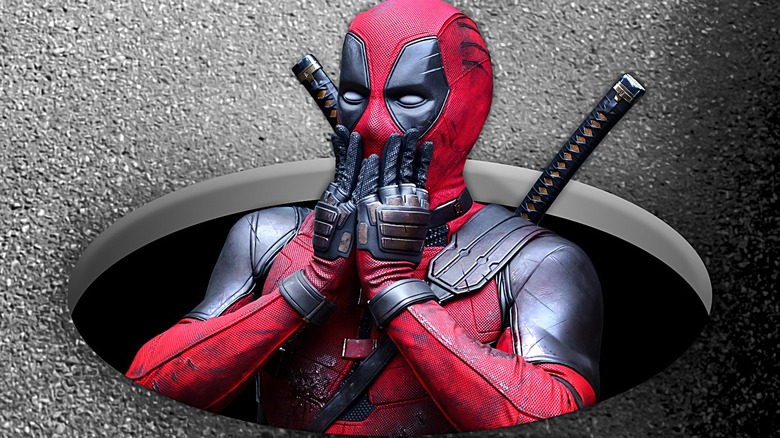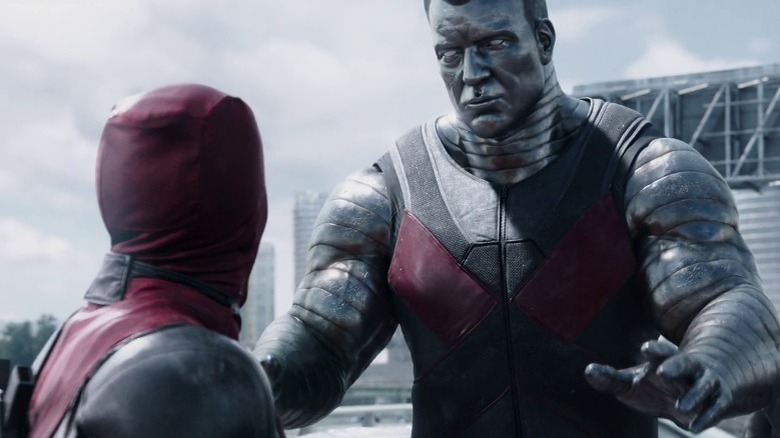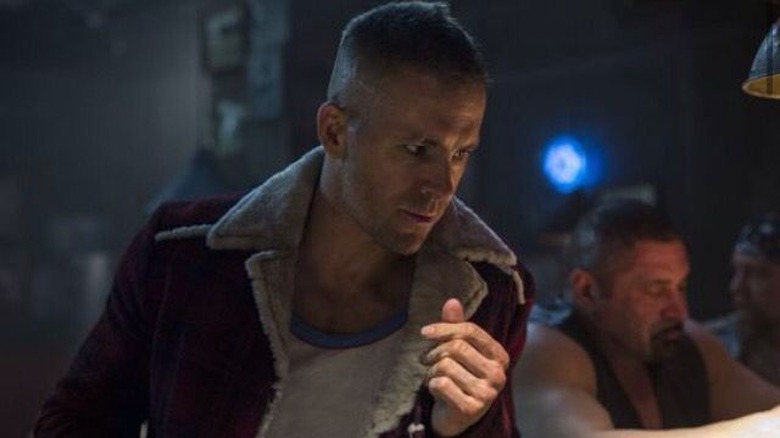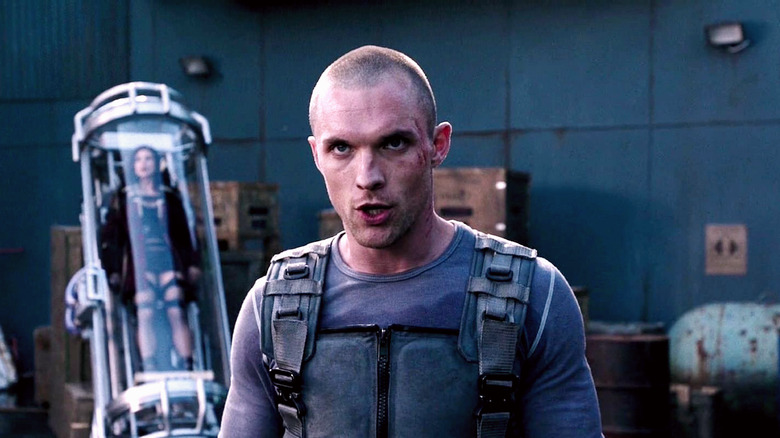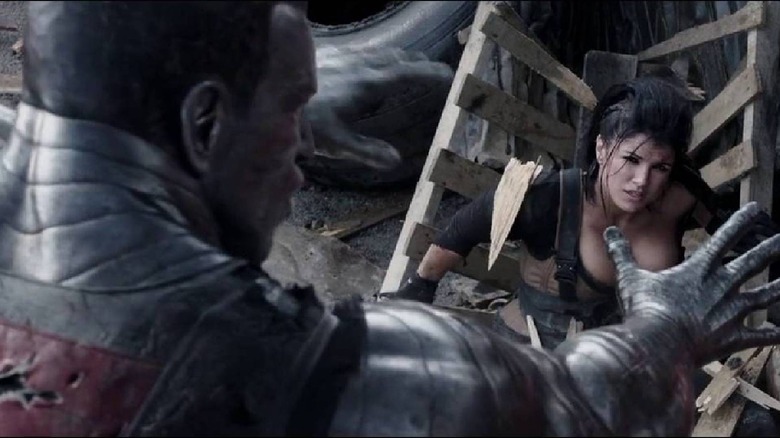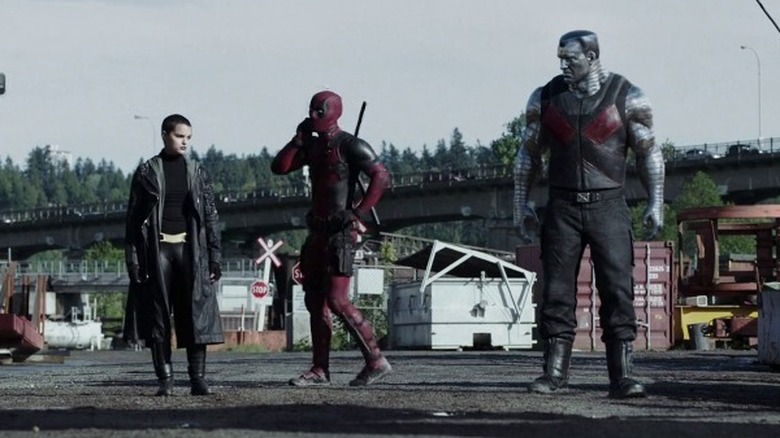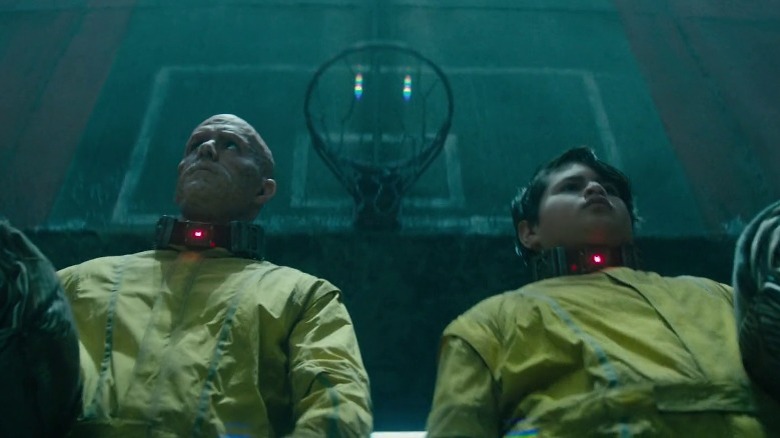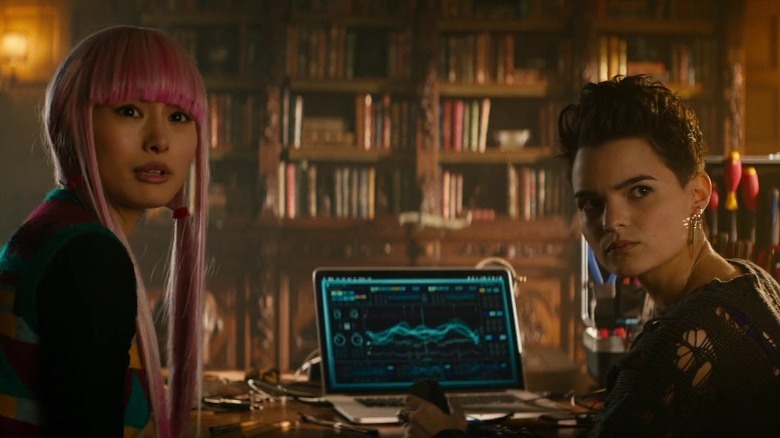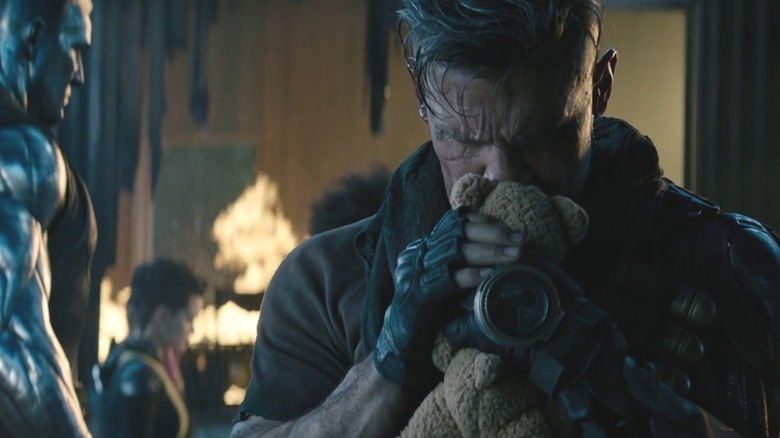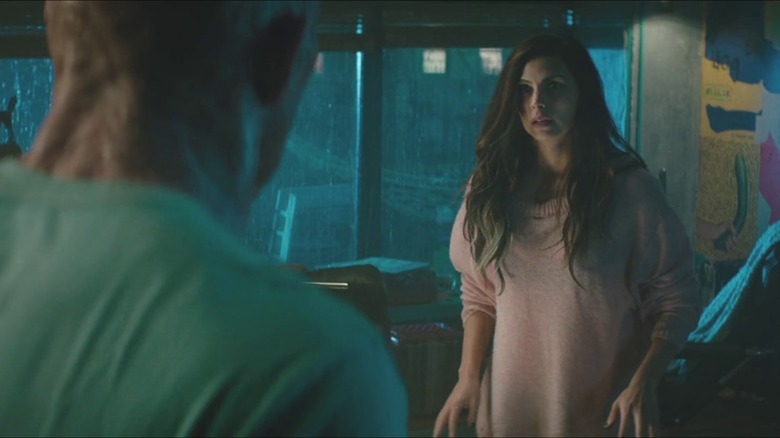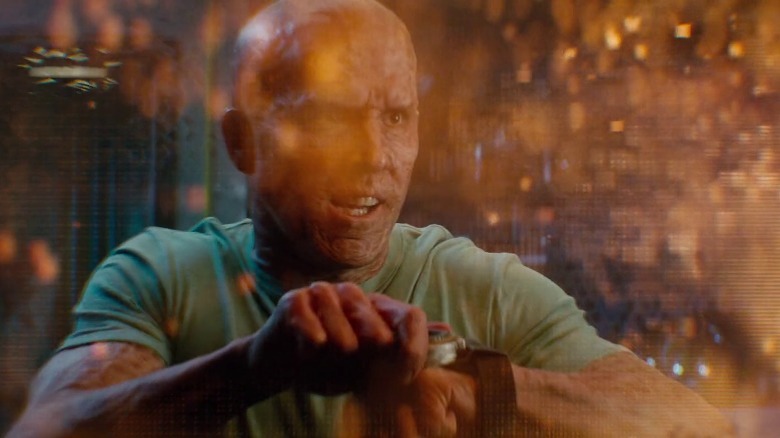The Biggest Plot Holes In The Deadpool Franchise
It almost feels wrong to go to the trouble of pointing out plot holes in the "Deadpool" films. Their whole reason for being, the thing that sets them apart, is that they're untethered from any and all rules — of logic, of diegesis, or even of propriety and good taste, as attested by the films' most controversial moments. It's easy to imagine Deadpool (Ryan Reynolds) himself laughing at the idea that anyone could take issue with a particular inconsistency or unexplained flight of writerly fancy in one of his tales — as if his whole existence weren't all flights of fancy, all the time.
Still, there are some things that even all the humor and lampshade-hanging in the world can't disguise, and one of them is that the franchise has moments of strained credibility. If the "Deadpool" films ultimately try to have their cake and eat it — spoofing and mocking superhero movies and their drama, yet simultaneously concocting earnest, dramatic stories that we're largely meant to take seriously — the logical frailty of certain plot leaps is the big deterrent to the prolonged harmony of those two cinematic modes, keeping Deadpool's entire movie timeline from hanging together perfectly.
There are a handful of moments when an attentive viewer might be too puzzled by the plot to laugh at the gags, which is unlikely to be what the filmmakers intended. For your appreciation, here are 11 of the biggest and most glaring plot holes in the "Deadpool" films.
When were Deadpool and Colossus in touch?
The first "Deadpool" film adopts a how-we-got-here structure. Starting in media res during the Merc with a Mouth's fight with Ajax's (Ed Skrein) men on the expressway, the movie then pauses — aided by helpful fourth-wall-breaking narration from the man himself, of course — and goes back in time to show how Wade Wilson got to that point. We learn about how he was discharged from the Canadian Special Forces, how he became a mercenary, how he met Vanessa (Morena Baccarin), how he was diagnosed with terminal cancer, and how he underwent the experimental treatment that gave him healing abilities and ultimately led him to adopt the identity of Deadpool.
What we do not see, at any point, is Colossus (Stefan Kapičić) reaching out to Deadpool to invite him to join the X-Men. Yet, when Colossus and Negasonic Teenage Warhead (Brianna Hildebrand) are shown watching the TV newscast of Wade's expressway mayhem, in a scene that sets up their later intrusion on the incident, Colossus mentions that he has made contact with Deadpool multiple times to attempt to bring him into the fold. "I've given Deadpool every chance to join us, but he'd rather act like a child," the steel giant laments. When were those chances given, exactly? The film recaps Deadpool's backstory as extensively as possible, going through virtually every step of his (anti)hero's journey, yet makes no mention of Colossus' supposed constant efforts to recruit him.
Wade sure was lucky to develop the exact right mutation
Although details of Wade Wilson's past are kept comically (and sometimes dramatically) vague, mutable, and even incoherent in the comics, the canon explanation for how he got his powers is pretty close to what we get in the 2016 film: He developed terminal cancer, was offered an experimental treatment for it, and the treatment in question both disfigured his body and imbued it with regeneration powers. The comics frame the treatment in question as part of the Weapon X government program, whereas Ajax is behind it in the film.
But there is another respect in which the two backstories differ — one which, although less narratively significant, does point to a significant logical head-scratcher in the adaptation. Per the comics, Wade was specifically injected with a healing factor extracted from Wolverine, a fellow test subject in the Weapon X program. In the film, however, Ajax observes that Wade is merely being injected with a serum that will activate any mutant genes in his DNA — whatever they may be. "The treatment affects everyone differently," he observes.
In other words, there's no telling whether Wade will develop the regeneration abilities required to cure his cancer and turn him into the human weapon intended by Ajax, or a different set of powers altogether. Ajax himself can't know what will happen — yet his whole plan banks on Wade being cured. Talk about a leap of faith.
Ajax's powers are completely inconsistent
Ed Skrein is no stranger to playing villains whose willingness to unflinchingly inflict pain and suffering is so thorough that it veers from cold and unfeeling into outright psychotic; that's true of his characters in "Alita: Battle Angel," "Rebel Moon," and even "If Beale Street Could Talk." The Skrein villain persona was both codified and literalized in "Deadpool," with Ajax being presented as a character who literally lost the physical ability to feel, and the emotional ability right alongside it. Although Ajax's powers are fuzzily defined, we do know that being injected with the serum enhanced his reflexes and scorched his nerve endings, thus ridding him of pain — as well as, presumably, any other tactile sensation.
Once that's been established, however, the movie basically asks us to just go along with everything Ajax does in the story. Strict immunity to pain can help explain some of his enhanced strength and resistance, since much of the physical limitation to both those attributes in humans stems from the pain of muscular exertion. But it most certainly does not explain how or why he could survive, say, literally having an entire sword driven through his torso, then being run over by a massive container, then tumbling down yards and yards of hard concrete blocks on a collapsed helicarrier. We know Deadpool's powers allow him to go through that sort of stuff, but Ajax's powers ... well, what even are they, exactly?
Where does Angel Dust go?
Like any superhero movie villain worth their salt, Ajax is aided in his exploits by a tough, hypercompetent, equally sociopathic right-hand — the super-strong, adrenaline-fueled Angel Dust (Gina Carano), who also got her powers from being subjected to the mutant activation serum. The character proves herself to be the out-and-out strongest in the film, even out-brawning Colossus — much to his chauvinistic surprise, right after claiming he would "prefer not to hit a woman."
It's understandable why Angel Dust didn't show up in "Deadpool 2" and isn't slated to appear in "Deadpool and Wolverine" either: the character wouldn't have much of a place in a sans-Ajax storyline, and then there's the whole issue of Carano having outed herself as a transphobic bigot and being fired from "The Mandalorian" in 2021. But "Deadpool" doesn't exactly give her a proper stage exit either.
In the final battle, as she is about to strangle Colossus to death with a steel rope, she is hit with a massive explosion created by Negasonic Teenage Warhead, which sends her flying into a metal structure. It briefly appears that she might have bit it, but then, a few shots later, Colossus is seen carrying her and NTW off to safety, both very much alive. After that, Angel Dust is never seen again. When Colossus and his teen protegé ride off into the sunset, she goes completely unmentioned. DId she sit on the sidelines, licking her wounds, and secretly watch Wade and Vanessa's closing kiss?
Why doesn't Deadpool pick up goons' guns if he misses his own?
Part of the appeal of the "Deadpool" movies comes from the degree to which they delight in subverting expectations via unexpected comic twists. The best example of that is arguably the duffle bag gag. In the bit, Deadpool, Colossus, and Negasonic Teenage Warhead are driven to the scrapyard where they're facing down Ajax's goons by Dopinder (Karan Soni), the friendly but possibly psychotic cab driver who idolizes Deadpool. The merc is carrying a duffle bag loaded with guns and ammo — but he leaves it in the passenger's seat of the cab, and is then unable to reach Dopinder's phone after Dopinder gets into a car crash. As a result, Deadpool is forced to face the goons with nothing but his two swords.
While the point of that storytelling choice is essentially to be funny and set up the sword action of the climax, it creates a logical hole. If being gunless frustrates Deadpool so much, why doesn't he simply pick up one or more of the many guns left lying around by the men he's killing with the swords? It would certainly make things a lot easier, terrific as the swordfighting scenes may be. Come to think of it, what's actually forcing him to put in the "maximum effort" of going blade-only is narrative necessity.
How exactly does the power-limiting collar work?
In "Deadpool 2," a central plot point is the arrest of both Russell Collins, aka Firefist (Julian Dennison), and Deadpool himself. After Deadpool realizes Russell has been abused by the orphanage staff and opens fire against them — Deadpool does has a moral code — both characters find themselves in the special mutant prison known as the Ice Box, wearing "power-dampening collars" which can allegedly only be removed with grenades.
The film never really bothers to establish consistent rules for the functioning and the resilience of the collars, however. For starters, it's unclear just how resistant and irremovable they're really supposed to be; all it takes is one fall during the prison brawl and one blunt impact against the floor for Wade's collar to break — certainly less brute force than a grenade. Then, towards the end, all Russell needs to do to open Wade's collar is pick the lock and type in the password "7."
The real sticking point, though, is that there's no consistency to whether or not the removal of the collar allows Wade to retroactively regenerate — as if the question of whether Deadpool can die weren't complicated enough already. The fall during the prison brawl kills him, yet he's back on his feet as soon as the collar is off. In the climax, meanwhile, Wade is shot dead while wearing the collar, and it's presented as a given that removing the collar would not bring him back. So what's the truth?
Since when is Negasonic Teenage Warhead a tech whiz?
Negasonic Teenage Warhead is a shining example of a great superhero movie supporting character: dry and droll without falling into a stock "deadpan snarker" stereotype, strong and intense without sacrificing recognizable humanity, and incredibly badass as both a fighter and a team member, with arguably the coolest superpower out of anyone in the "Deadpool" ensemble.
She's also a model of female characterization done right in a franchise that can get rather aggressively macho at times, and a trailblazer as one half of the first prominently-featured LGBTQ+ relationship in a mainstream superhero film alongside Yukio (Shioli Kutsuna). The one thing she is not, at least not up until the exact point when it becomes convenient for the plot, is a tech genius.
Granted, we see little of her life outside the scenes she shares with the rest of the team, but even so, the film could have done something, anything, to establish that particular skill in advance. Instead, the post-credits sequence of "Deadpool 2" just goes ahead and has NTW fix Cable's (Josh Brolin) time travel device without any prior setup. It would be one thing if she were simply displaying strong abilities for a teen with an interest in science and robotics. But to understand futuristic tech and then fix it without breaking a sweat, you'd have to be the kind of brilliant that the movie would want to mention at least once.
Cable's time shenanigans are rather messy
"Deadpool 2" generally keeps the characters and the stakes clear enough, emotionally speaking, to ensure that the time travel plot stays engaging even as it gets convoluted. But boy, does it ever get convoluted. The mechanics of Cable's plan alone are rather fuzzy, if not outright incoherent. We know that he's gone back in time to prevent Russell from growing up into the serial killer who will murder his wife and child. But it seems like the very fact of Cable's intrusion into Russell's life — attempting to murder him in the Ice Box and starting the brawl that allows Deadpool to break out of prison and free Russell — is what starts Russell on that path in the first place.
If Cable never goes back in time, Russell wouldn't break out of prison the way he does. It seems that the film hinges on the idea that Russell would have broken out anyway at some point without Cable's contribution, but that's never established clearly enough.
What's even iffier, though, is the final sequence in which Cable goes back in time several minutes to save Wade's life. In that moment, the movie abruptly changes its time travel dynamic from "hopping into the past" to "rewinding time." If the time travel rules had remained consistent, there should be two Cables walking around when he leaps a few minutes back into the past.
How does Wade save Vanessa?
Even the time travel inconsistencies in "Deadpool 2" are small potatoes compared to the plot crater created by Wade's decision to go back in time and rescue Vanessa. The entirety of "Deadpool 2" is predicated on the idea that changing the past changes the future — if Cable goes back in time and kills Russell Collins before he becomes a serial killer, his family is saved. In other words, any actions taken in the past irrevocably alter the circumstances of the future. So how is it possible that, when Deadpool goes back in time to save Vanessa from the man who killed her, that doesn't immediately prevent the plot of "Deadpool 2" from ever having occurred in the first place?
This is one of those big honking time-travel paradoxes that most stories of the sort have to put in strenuous effort to avoid: Saving Vanessa means Deadpool never joins the X-Men and crosses paths with Russell and Cable, but that, in turn, means he never goes back in time to save Vanessa. The unsolvability of that conundrum might explain why the saving of Vanessa is tucked away in the film's end credits, almost as a comedic tag rather than a dramatic beat. It might just work better if you don't think about it too much; after all, the same solution-eliminates-solution dynamic technically also applies to Cable's plot, and that's a whole other can of worms.
Deadpool's time travel isn't really MCU-consistent
There's a reason why the Marvel Cinematic Universe — arguably the franchise most defined by the primacy of internal logic and rulebook consistency — opted for multiverse-jumping time travel. The only way to introduce time travel into a narrative without creating the kinds of circular paradoxes seen in "Deadpool 2," basically, is to go the way "Avengers: Endgame" went: What has happened has happened, the past cannot be changed, but pasts in alternate timelines can be visited and altered, thus branching off into new timelines. That time travel model, in fact, makes up the very core of the multiverse mechanics introduced in Phase Four of the MCU.
Deadpool is now being dropped into the middle of that multiverse, with the plot of "Deadpool and Wolverine" concerning not only his introduction into the MCU, but also his visit into a specific timeline where Wolverine (Hugh Jackman) has failed the populace. In other words, "Deadpool and Wolverine" incorporates an MCU-style multiversal structure. The problem is that this multiversal structure is not consistent with linear time travel, as seen in "Deadpool 2." If changing the past changes the future, then there's only one universal timeline stretching out across all of history. How can two film universes with such different concepts of fate and time travel be integrated successfully in a multiverse-themed film? And how does a time-travel device allow allow Wade to move between different realities?
